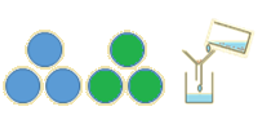×










CHEMISTRY FORM 1
i Common Chemistry Laboratory Chemicals

ii Common Chemistry Laboratory Apparatus

iii Safety in the Chemistry Laboratory

iv Why we should learn Chemistry

1. INTRODUCTION TO CHEMISTRY

- 1.1 What is matter?
- 1.2 What is Chemistry?
- 1.3 What does matter consist of?
- 1.4 Are the particles in matter stationary?
- 1.5 Arrangement, distance, and attraction between particles
- 1.6 Properties of matter (volume, shape and compression)
- 1.7 Conductors and non-conductors
- 1.8 Sources of heat
- 1.9 Bunsen burner
- 1.10 Role of Chemistry in society
2. SIMPLE CLASSIFICATION OF SUBSTANCES AND SEPERATION OF MIXTURES

- 2.1 Pure substances
- 2.2 Mixtures
- 2.3 Separation of Mixtures
- 2.4 Separation of solid-solid mixture
- 2.5 Separation of insoluble solid-liquid mixture
- 2.6 Separation of soluble solid-liquid mixture (solution)
- 2.7 Separation of immiscible liquid-liquid mixture
- 2.8 Separation of miscible liquid-liquid mixtures (solution)
- 2.9 Separation of liquid-gas mixture
- 2.10 Selecting and using appropriate methods of separating mixtures
- 2.11 Kinetic theory of matter
- 2.12 Classification by physical states
- 2.13 Effect of heat on physical states
- 2.14 Effect of impurities on melting and boiling points
- 2.15 Permanent and non-permanent changes
- 2.16 Definitions, chemical symbols and equations
3. ACIDS, BASES AND INDICATORS

- 3.1 Simple acid-base indicators
- 3.2 Universal indicators and pH scale
- 3.3 Reactions of acids with metals
- 3.4 Reactions of acids with carbonates and hydrogen-carbonates
- 3.5 Reactions of acids with bases
- 3.6 Effects of acids on substances
- 3.7 Applications of acids and bases
4. AIR AND COMBUSTION

- 4.1 Composition of Air
- 4.2 Fractional distillation of liquid air
- 4.3 Rusting
- 4.4 Oxygen
- 4.5 Burning of substances in air
- 4.6 Atmospheric pollution
5. WATER AND HYDROGEN

- 5.1 Candle wax and water
- 5.2 Reactions of metals with liquid water
- 5.3 Reaction of metals with steam
- 5.4 Preparation of hydrogen gas
Content developer

Simple Classification of Substances and Separation of Mixtures: Seperation of Mixtures
2.0 Simple Classification of Substances and Separation of Mixtures 
2.3 Separation of Mixtures
General principles of separating mixtures
A mixture consists of two or more substances, which are referred to as components of the mixture. If a pure substance is required, it must be separated from its mixture. Separation of a mixture makes use of the differences in properties between its components.
- If one component is magnetic and the other is not, then we use magnetic picking. If both components are magnetic or non-magnetic, then magnetic picking cannot work.
- If one component sublimes and the other does not, then we can apply heat to expel the volatile component (which sublimes) and cool it back to a solid (sublimate). The method is called sublimation.
- If one component (usually liquid) has particles that are small enough to pass through a filter paper and the other does not, then we use filtration method.
- If a heavy solid component of a solid-liquid mixture has completely settled at the bottom of a container, then the liquid at the top can be gently poured into another container. The process is called decantation. It is suitable for clean heavy solids such as clean sand and water, or copper turnings and water.
- If one component readily melts and the other does not, then we can heat the mixture and filter it while hot, provided the melt does not dissolve the other component.
- If one component is soluble in water and the other is not, we can add water to the mixture and stir, filter off the insoluble component, then expel water from the solution by, say, evaporation to dryness. This method is solvent extraction.
- Evaporation to dryness leads to loss of one component (solvent). If we want to retain both components, then simple distillation is more appropriate.
- For solutions of two or more liquids which have different but close boiling points, the appropriate method is fractional distillation.
NB: Always use the shortest possible method to separate mixtures.
